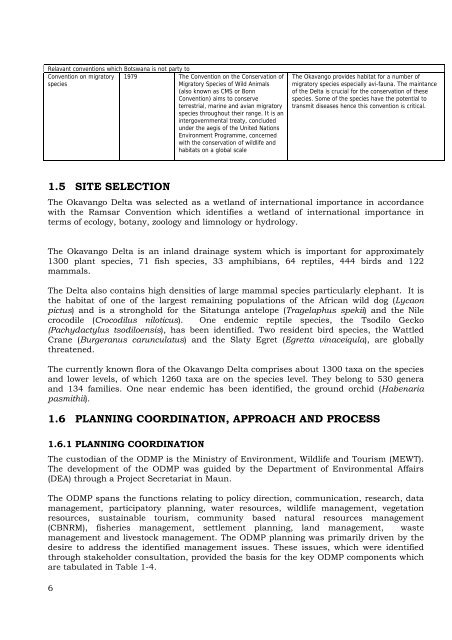Okavango Delta Management Plan - Ramsar Convention on Wetlands
Okavango Delta Management Plan - Ramsar Convention on Wetlands
Okavango Delta Management Plan - Ramsar Convention on Wetlands
Create successful ePaper yourself
Turn your PDF publications into a flip-book with our unique Google optimized e-Paper software.
Relavant c<strong>on</strong>venti<strong>on</strong>s which Botswana is not party to<br />
<str<strong>on</strong>g>C<strong>on</strong>venti<strong>on</strong></str<strong>on</strong>g> <strong>on</strong> migratory<br />
species<br />
1.5 SITE SELECTION<br />
6<br />
1979 The <str<strong>on</strong>g>C<strong>on</strong>venti<strong>on</strong></str<strong>on</strong>g> <strong>on</strong> the C<strong>on</strong>servati<strong>on</strong> of<br />
Migratory Species of Wild Animals<br />
(also known as CMS or B<strong>on</strong>n<br />
<str<strong>on</strong>g>C<strong>on</strong>venti<strong>on</strong></str<strong>on</strong>g>) aims to c<strong>on</strong>serve<br />
terrestrial, marine and avian migratory<br />
species throughout their range. It is an<br />
intergovernmental treaty, c<strong>on</strong>cluded<br />
under the aegis of the United Nati<strong>on</strong>s<br />
Envir<strong>on</strong>ment Programme, c<strong>on</strong>cerned<br />
with the c<strong>on</strong>servati<strong>on</strong> of wildlife and<br />
habitats <strong>on</strong> a global scale<br />
The <str<strong>on</strong>g>Okavango</str<strong>on</strong>g> provides habitat for a number of<br />
migratory species especially avi-fauna. The maintance<br />
of the <str<strong>on</strong>g>Delta</str<strong>on</strong>g> is crucial for the c<strong>on</strong>servati<strong>on</strong> of these<br />
species. Some of the species have the potential to<br />
transmit diseases hence this c<strong>on</strong>venti<strong>on</strong> is critical.<br />
The <str<strong>on</strong>g>Okavango</str<strong>on</strong>g> <str<strong>on</strong>g>Delta</str<strong>on</strong>g> was selected as a wetland of internati<strong>on</strong>al importance in accordance<br />
with the <str<strong>on</strong>g>Ramsar</str<strong>on</strong>g> <str<strong>on</strong>g>C<strong>on</strong>venti<strong>on</strong></str<strong>on</strong>g> which identifies a wetland of internati<strong>on</strong>al importance in<br />
terms of ecology, botany, zoology and limnology or hydrology.<br />
The <str<strong>on</strong>g>Okavango</str<strong>on</strong>g> <str<strong>on</strong>g>Delta</str<strong>on</strong>g> is an inland drainage system which is important for approximately<br />
1300 plant species, 71 fish species, 33 amphibians, 64 reptiles, 444 birds and 122<br />
mammals.<br />
The <str<strong>on</strong>g>Delta</str<strong>on</strong>g> also c<strong>on</strong>tains high densities of large mammal species particularly elephant. It is<br />
the habitat of <strong>on</strong>e of the largest remaining populati<strong>on</strong>s of the African wild dog (Lyca<strong>on</strong><br />
pictus) and is a str<strong>on</strong>ghold for the Sitatunga antelope (Tragelaphus spekii) and the Nile<br />
crocodile (Crocodilus niloticus). One endemic reptile species, the Tsodilo Gecko<br />
(Pachydactylus tsodiloensis), has been identified. Two resident bird species, the Wattled<br />
Crane (Burgeranus carunculatus) and the Slaty Egret (Egretta vinaceiqula), are globally<br />
threatened.<br />
The currently known flora of the <str<strong>on</strong>g>Okavango</str<strong>on</strong>g> <str<strong>on</strong>g>Delta</str<strong>on</strong>g> comprises about 1300 taxa <strong>on</strong> the species<br />
and lower levels, of which 1260 taxa are <strong>on</strong> the species level. They bel<strong>on</strong>g to 530 genera<br />
and 134 families. One near endemic has been identified, the ground orchid (Habenaria<br />
pasmithii).<br />
1.6 PLANNING COORDINATION, APPROACH AND PROCESS<br />
1.6.1 PLANNING COORDINATION<br />
The custodian of the ODMP is the Ministry of Envir<strong>on</strong>ment, Wildlife and Tourism (MEWT).<br />
The development of the ODMP was guided by the Department of Envir<strong>on</strong>mental Affairs<br />
(DEA) through a Project Secretariat in Maun.<br />
The ODMP spans the functi<strong>on</strong>s relating to policy directi<strong>on</strong>, communicati<strong>on</strong>, research, data<br />
management, participatory planning, water resources, wildlife management, vegetati<strong>on</strong><br />
resources, sustainable tourism, community based natural resources management<br />
(CBNRM), fisheries management, settlement planning, land management, waste<br />
management and livestock management. The ODMP planning was primarily driven by the<br />
desire to address the identified management issues. These issues, which were identified<br />
through stakeholder c<strong>on</strong>sultati<strong>on</strong>, provided the basis for the key ODMP comp<strong>on</strong>ents which<br />
are tabulated in Table 1-4.

















